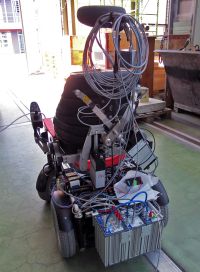Overview Structural Durability
Safety, reliability and profitability are core criteria for development and commercialization of products and their components. We offer support in issues regarding static and cyclic durability (lifetime) of materials, sub-assemblies and machine parts up to components and entire structures. Apart from measurements of representative service loads on components, also simulations of measured or given stress histories in a broad load range may be performed in the lab. Two universal floor slabs allow the realization of tailored test set-ups in order to experimentally determine the lifetime of test objects under realistic and customer specific loads.
As an independent, accredited laboratory for oscillating mechanical testing of materials, components and constructions according to ISO/IEC 17025 (STS 0053), a high quality lev-el of our services as well as extensive documentation are a matter of course.
Contact: Dipl. Ing. ETH Christian Affolter, Stv. Dipl. Ing. FH Alex Stutz
Our services - Consulting, planning and engineering

Measurement and evaluation of service loads

Customer specific test setups

Experimental investigation of fatigue properties on specimens

Numerical strength verification

Research and development projects - Shortened experimental method for determination of fatigue properties

Bainitic steels are used increasingly in the automotive industry. As for a reliable design of components, the strength capacity hasn't yet been fully exploited, improved steels, which show the so-called TRIP-effect (TRansformation Induced Plas-ticity), have been developed.
The investigation of mechanical fatigue properties in the course of material development processes by using standard fatigue tests is time consuming, costly and therefore, not economical. Based on modern models, a shortened, experimental method has been introduced and verified in the frame of a re-search and development project. This method enables the es-timation of a complete SN-curve (limited life time and fatigue strength) carrying out three to five fatigue tests.
Contact: Dipl. Ing. ETH Ch. Affolter, Dipl. Ing. FH A. Stutz
Application of pre-stressed carbon fiber laminates for enhancing the lifetime of an artwork pendulum

An artwork pendulum was manufactured from three steel box girders which were connected with hexagon head screws. After about two years of operation, some screw heads have broken. As a repair solution the two girder joints were welded and all screws replaced. At the same time computational analyses were carried out to proof the fatigue strength of the screw connections as well as of the new welding. The results showed that neither the screw connections nor the new welding exhibit the necessary fatigue strength. Consequently, an alternative reinforcement of the pendulum was necessary to keep the artwork in service. The application of pre-stressed carbon fiber laminates shift the mean stress of the welding into the com-pression range. This restrains the opening of welding defects and micro cracks, whereby a possible crack growth will be re-duced and the lifetime of the pendulum will increase. The strengthened pendulum has been working successfully for more than 13 years without any indication of fatigue cracks (see Paper "CFRP-Strengthening and Long-Term Performance of Fatigue Critical Welds of a Steel Box Girder", R. Koller et al., Polymers 2014).
.

